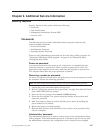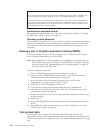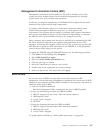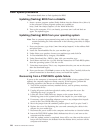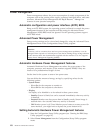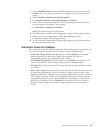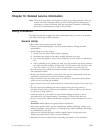
Note:
This computer has Enhanced Security Mode. If Enhanced Security mode is enabled and
there is no password set, the computer will act as if Enhanced Security is disabled.
If Enhanced Security is Enabled and an administrator password is set, the administrator
password must be entered to use the computer. If the administrator password is lost or
forgotten, the system board in the computer must be replaced in order to regain access to
the Configuration/Setup Utility program.
Administrator password control
The Administrator password is set in the Setup Configuration. Refer to “Starting
the IBM Setup Utility program” on page 19.
Operating system password
An operating system password is very similar to a power-on password and denies
access to the computer by an unauthorized user when the password is activated.
The computer is unusable until the password is entered and recognized by the
computer.
Erasing a lost or forgotten password (clearing CMOS)
This section applies to lost or forgotten passwords. For more information about
lost or forgotten passwords, go to Access IBM.
Note: Some models have a POV daughter card installed on the system board. In
these models, the password is stored in the EEPROM on the POV card and
cannot be erased. See “Identifying parts on the system board” on page 28
for the location of the POV card.
To erase a forgotten password:
1. Refer to “Identifying parts on the system board” on page 28
2. Locate the Clear CMOS/BIOS recovery jumper on the system board. See
“Identifying parts on the system board” on page 28
3. Move the jumper from the standard position (pins 1 and 2) to the
maintenance or configure position (pins 2 and 3).
4. Install the PCI riser and adapters if removed.
5. Lower the drives and reconnect any cables that were disconnected.
6. Close the cover and connect the power cable. See “Closing the cover and
connecting the cables” on page 46.
7. Restart the computer, leave it on for approximately 10 seconds, and then turn
off the computer.
8. Repeat step 1.
9. Move the CMOS/BIOS recovery jumper back to the standard position (pins 1
and 2).
10. Reassemble the computer and close the cover. See “Closing the cover and
connecting the cables” on page 46.
Vital product data
Each computer has a unique Vital Product Data (VPD) code stored in the
nonvolatile memory on the system board. After you replace the system board, the
VPD must be updated. To update the VPD, see “Flash update procedures” on page
148.
146 Hardware Maintenance Manual










